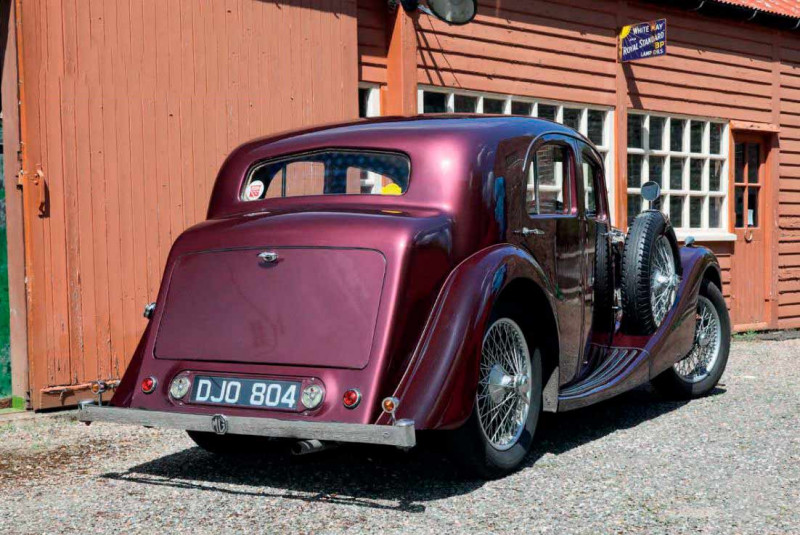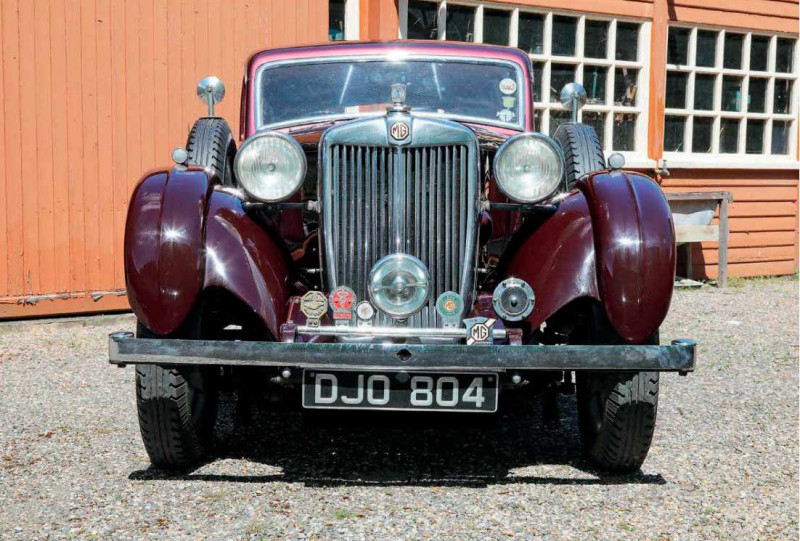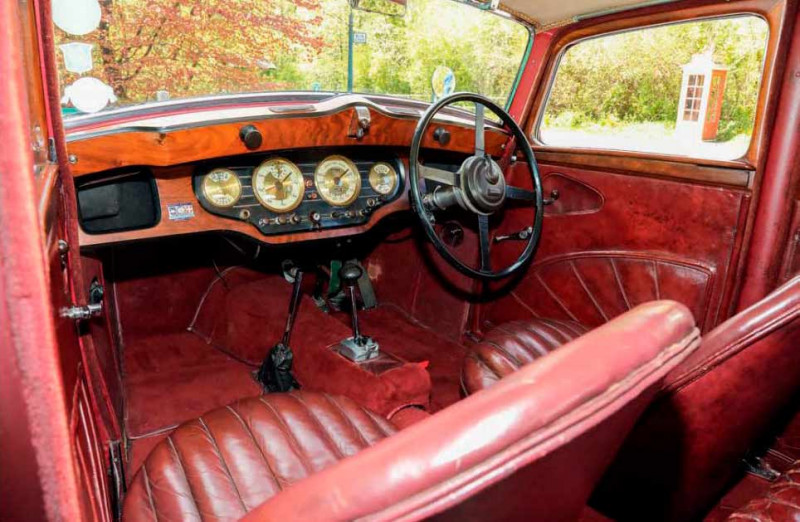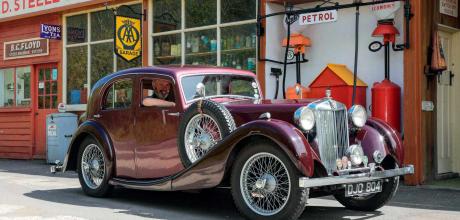1936 MG VA
The last known surviving pre-production MG VA is itself a rarity amongst the rare but Ian Burton is determined to experience and share its history. Words: Aaron McKay. Photos: Jim Jupp.
The show car
Think pre-war MG and, apart from the very beginnings, your most likely conjured images will be of a little Midget or perhaps a six-cylinder car. In the sensible middle ground there is often forgotten the MG flair that graced the one-and-a-half-litre touring class. This was the VA.

Nearly a century on, Ian Burton found the VA to carry as much appeal as a pre-war classic as it did as a new car back in 1937. It’s spacious, important for someone 6’4 tall, and comfortable for the touring that’s as much a reason for buying an MG as ever. It’s also pretty good value. There’s inevitably an element of historical appreciation too, especially if you end up buying a preproduction model.
No stranger to either MGs or pre-war classics, Ian has owned both an MGB Jubilee and an Austin Seven Ruby for nearly 50 years. When it came to buying another pre-war car, he naturally sought specialist and club support. It was Robin Lawton, vintage and classic car specialist in Hampshire, who introduced Ian to the car and, since then, Ian has enjoyed the support of the highly knowledgeable SVW Register of the MG Car Club.

“I’d gone to see a Riley Gamecock but discovered I couldn’t fit.” It was then that Robin pointed out the MG VA which, it turned out, fit Ian like a glove. “We saw the car and instantly fell in love with it.” It was a new experience for him, having never seen, and hardly even heard of, the VA before, something which seems to be the case across the whole classic scene. It’s almost a forgotten car, Ian tells me, but it’s a significant piece of history as well as just a practical pre-war car. “It shows all the signs of the tension at MG at the time, under Nuffield, with evidence of having to use as many Morris parts as possible while the Competitions Department was, sadly, knocked on the head.” The VA was, and still is, a rational car but with a fascinating history.
But there’s unmistakeable MG character here, from engineering input, evidenced in things like the D.O. stamp on the Morris-derived cam-and-peg steering system, to the countless nods to the octagon littered about. It’s a sleek number, as Ian explains enthusiastically: “there’s not a straight line on it.” It’s remarkable how good it looks for being only 14 feet long and, apart from a roofline that lingers a little high at the back, it’s pretty much as elegant and luxurious looking as the much larger SA.

The VA’s special character inspired Ian to get more involved with the social aspects of MG ownership. “I hadn’t been a member of the MGCC but joined with the VA because they have this excellent Register, lots of like-minded people and, in fact, they have their meeting at the end of July.” There was also invaluable knowledge to gain from the SVW Register, some of which helped illustrate his VA’s unique history.
This particular car is rather special because it is number 0251, the first VA ever made. The number funnily enough, relates to a telephone number at Abingdon. Its provenance as a preproduction car was largely uncovered by the now sadly departed Bas de Voogd. “He did a phenomenal amount of research on the car,” explains Ian. “It’s where a lot of the information has come from.” Bas de Voogd bought the car in 1981, found while on holiday in England and flicking through a copy of Exchange and Mart. It was advertised then as a pre-production prototype and the story goes that the then-owner had bought it in the early 1960s for £25 with a bonus box of chocolates because he had recognised the special chassis number.
At this time, the VA was in a dark green colour but otherwise rather original. Bas de Voogd even noted that it still had its original engine with engine number 6303/1. It was, however, not running and, when he did get it up and going with some minor fuel and ignition system recommissioning, it was clear that the engine required a full rebuild.
The restoration ran its course over the 1980s at a gradual pace. Bas decided to fit a B-series engine and automatic gearbox from a Marina, setting aside the original drivetrain for the future. This was a point of necessity for him for he was increasingly unable to drive the car in its standard state owing to his health. He went to great pains to keep it otherwise intact, however.
The original transmission tunnel, for example, was switched out and preserved. Bas also went the extra mile when the VA needed a new headliner; he tracked down a former factory worker to produce the detailed edging so that it would be exactly right.
During these years Bas de Voogd investigated the car’s history in detail. Lines of correspondence were built up with many of the previous owners and, although there remain a couple of gaps, the results illustrate the car’s history in great colour; quite literally, in fact. Documents detailing its original purpose as a pre-production and show car now reside with Ian Burton but what happened with it between 1936 and 1959, after which it appeared for sale on the Wimbledon Motorworks forecourt, isn’t entirely known.
Nevertheless, it survived and apparently gained one extra wheel so that it now features a spare on each forward running board. Also in this time it appears to have been rebuilt with panels finished in the maroon colour it wears today. Whether or not this was the result of accident damage is speculation of course but a good guess. During its restoration, in the 1980s, it was restored to this maroon colour because of markings on the majority of its panels. It was only later discovered to have originally been finished in a cream colour thanks to research confirming its identity as one of the three VA show cars at the 1936 Olympia Motor Show. Since then its wheels have been painted silver.
This special VA, 0251, known by the number plate ABL 999 before it was later registered as DJO 804, featured a few eccentricities unfamiliar to the standard-run VA models. All the chassis castings, spring hangers and the steering box support, for instance, are made out of manganese bronze. The inner chassis rails had, at one time, been lightened with oblong holes which have since been filled in. Bas even spoke with former factory hands to complete what was becoming an illustrative story.
Other little details might be left to the keen-eyed among you. If you’ve noticed that the headlights (and scuttle) are from a TA-type Midget, then you’ll have spotted also that the sidelights are from an earlier PA. The car was originally not fitted with a rear bumper, to Cecil Kimber’s taste for tidy lines, but one had to be added for it to be sold later. Also unique to this pre-production model are running strips which don’t extend onto the front wing. The original engine has since been refitted and bored out from 1584cc to 1740cc (as cars would have been supplied for use by the police).
Inside there are more suggestions of its pre-production status: the dashboard centre panel is made from that of an SA, the same source as the gear lever unlike production models. It’s a marvel of history that all of it has survived in its original state for so long, something which Bas de Voogd noted when he bought it in 1981 and now something that Ian continues to appreciate. The car had returned to the UK in 2008, its owner then Keith Bush, who continued to look after it well. Sadly, Keith has recently passed away but his care of the VA is evident in its condition today.
Its original drivetrain was rebuilt, upgraded, and reinstalled while a few other changes were made including telescopic dampers, revised electrics and a cartridge oil filter system. Ian, the current owner, has now had the VA for a year. There’s a mixture of dedication and enthusiasm in Ian that promises a good future for the VA. “We purchased the car as we wanted to assist with the conservation of a pre-war classic, as well as for touring,” he says.
“I simply find it a bit of a privilege to own a car for a period of time. It would be great to pass it on to new owners in a good condition.” With an enthusiasm for getting the car out and about in the near future, he has the idea of fitting an overdrive unit just as Keith had considered. “There’s always a dilemma when fitting these sorts of things. At 4000 revs you’re only at 60mph so overdrive would make it more relaxing but it’s expensive to do and it wouldn’t be original. It wouldn’t be as it was.”
For now, Ian and his wife Liz are happy simply to enjoy the car, its history, and keep on top of the maintenance of this piece of MG history. “We’ve sorted a couple of oil leaks, paid some attention to servicing and spent time getting to know the car and its history.” It gets looked after by Paul Bros in Bognor Regis, local to Ian, where the mechanics love the sight of the VA. “He couldn’t wait to get his hands on it,” recalls Ian. Paul Bros has built up a reputation for servicing classic MGs in the area but the VA was certainly something unusual for them and always provokes a reaction.
The other ambition for Ian is to get the novel four-corner hydraulic jacking system working. This so-called Smiths Jackall System had been standard on the SA, optional on the VA, and was installed on 0251. However, it is not currently working. Ian agrees it will certainly draw attention at the shows when it does but it’s also part of the VA experience. “What I like about a car like this is to keep all the original features working. To have it as it would have been.” The agenda for the near future is attending the shows. It will undoubtedly join the various MGCC SVW Register events but will also make an appearance at some others so that the VA can get some well-earned recognition. For conserving and promoting the prewar classic MGs, we think that pursuing the hobby in a VA is exceptionally inspiring. We can’t wait to see it again.
IT WAS THEN THAT ROBIN POINTED OUT THE MG VA WHICH, IT TURNED OUT, FIT IAN LIKE A GLOVE.
The production number VA/0251 makes this the earliest VA… not just in existence but ever made, confirmed on this plate. There remain many satisfying signs of this car’s originality, from another, earlier time like this radiator stamp. The original engine and gearbox are now back in place and running sweetly.
Evidence of an engine rebuild with meticulous attention to original detail; the correct brass piping with the octagonal dipstick top also in view, now well run in. Morris components tell a political story at MG during the Nuffield takeover. Revised 12 volt electrics are amongst a few minor changes from original specification that subtly aid use.
Ian’s long-legged seating position still affords just enough room in the back for passengers. Original, adjustable Luvax dampers were replaced with superior telescopic, passive items by previous owner Keith. Fly-off handbrake and SA gear lever are just two of the eccentricities by this car’s status as a pre-production model.
The headlights are from a TA and their supports are made out of a high-nickel-content metal unusual to production VAs. This rear bumper was added only after its publicity duty because the car then had to comply with safety regulations to be sold.
ALL THE CHASSIS CASTINGS, SPRING HANGERS AND THE STEERING BOX SUPPORT, FOR INSTANCE, ARE MADE OUT OF MANGANESE BRONZE
Archivist Anders Clausager’s response to Bas de Voogd’s enquiry into the car’s history. Dated 1981 this was the breakthrough to uncovering its story although some details like its original colour were not yet confirmed.
This early publicity photograph likely from 1936 shows 0251 wearing its ABL 999 number plate, no rear bumper, and finished in a light colour now known to be Cream.
This photograph was taken soon after the car’s restoration in the 1980s, temporarily wearing its publicity registration number plate for effect, not to mention the matching backdrop.
IT WAS ADVERTISED THEN AS A PRE-PRODUCTION PROTOTYPE AND THE STORY GOES THAT THE THENOWNER HAD BOUGHT IT IN THE EARLY 1960S FOR £25 WITH A BONUS BOX OF CHOCOLATES…


